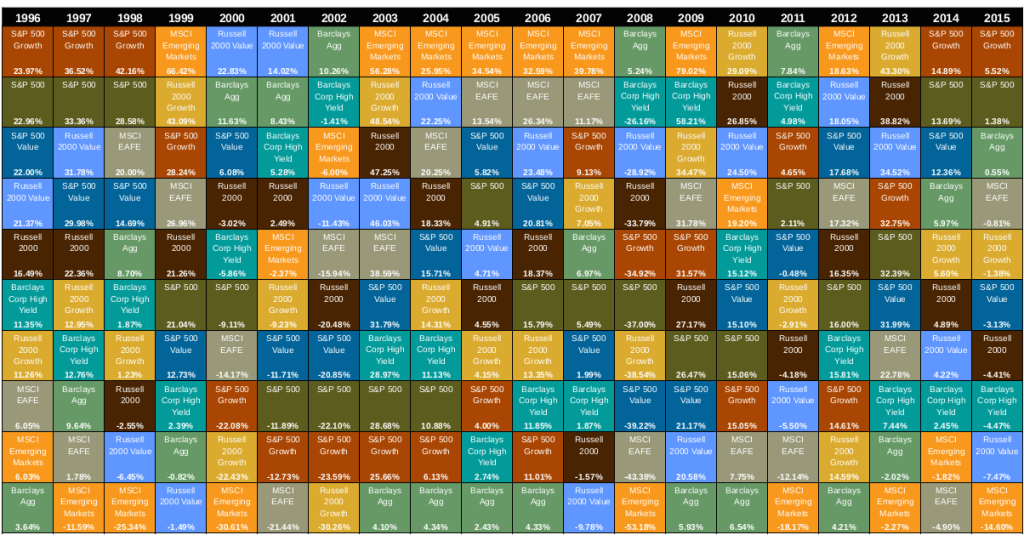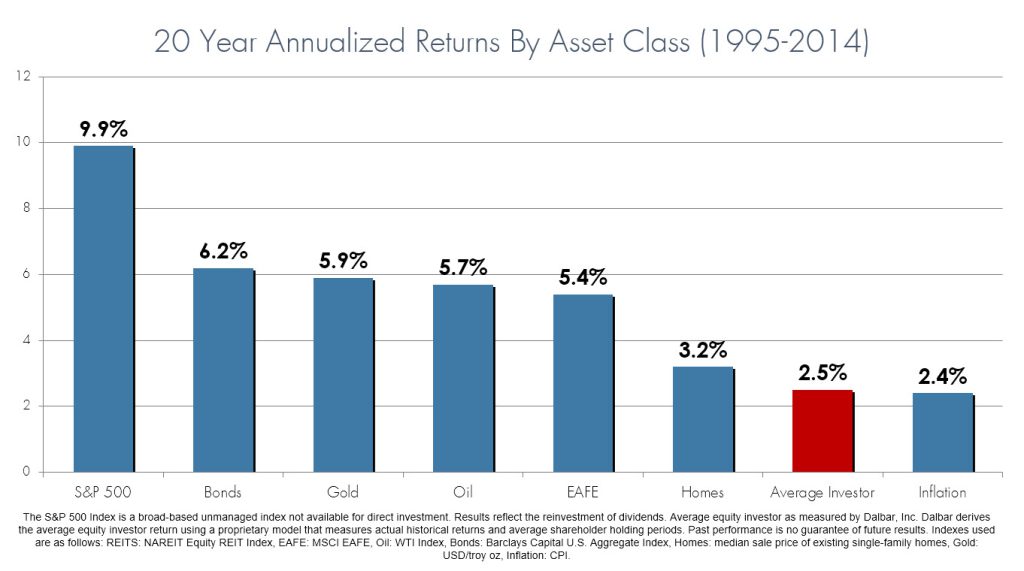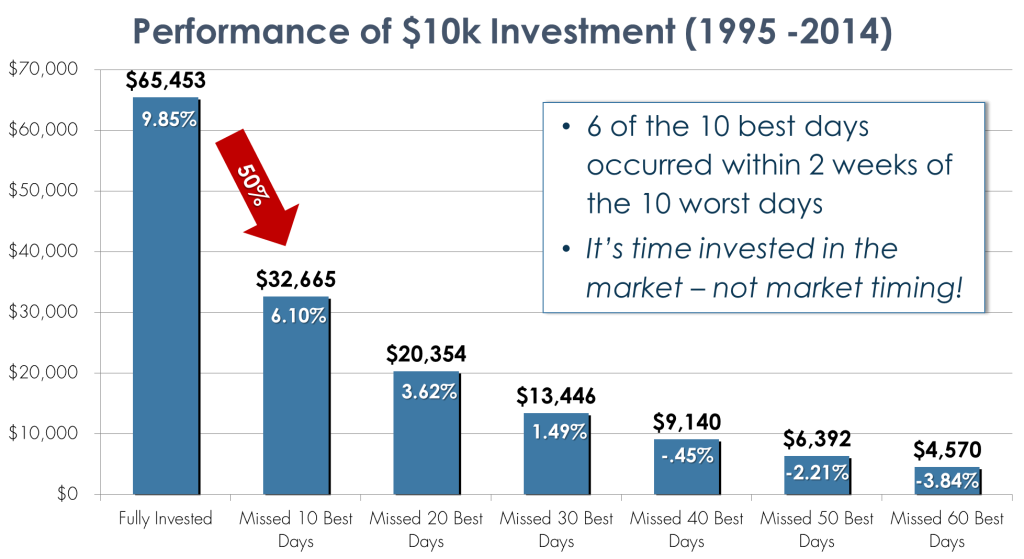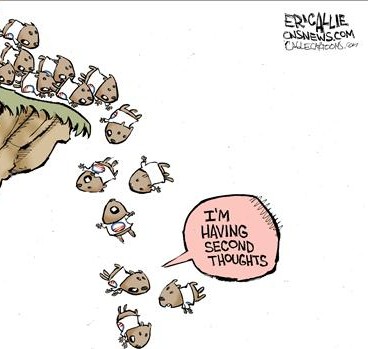If we look over the past 15 years or so, it’s easy to understand why investors have been nervous. When the tech bubble burst in 2000, the market declined by almost 50 percent over 31 months. The market rebounded the next five years to a peak in October 2007, only to lose more than 57 percent over 17 months. Downturns like this left many people in severe debt, subjecting them to the mercy of collection agencies aiming to profit on their debts.
Since then, the market has made a slow and volatile climb to an all-time high and gain of more than a 170 percent return! With so much progress being made, many people are beginning to wonder if we’re due for a retreat. And if we do see a decline, how should we prepare in advance for it? What are the best investing tips to make money and protect money in the stock market? Click here to learn three stock market lessons we learned for this year!
The truth is, no one can say for sure when the market will go down or go up. An interesting study by Bloomberg showed that the companies Wall Street analysts said to “sell” outperformed the market by 25 percent, while the stocks they said to “buy” underperformed by 7 percent. In other words, if you had followed the opposite advice of Wall Street professionals, you would have outperformed the S&P 500 by 7 percent!
Then what is the most important investment decision you can make and best way to make money in the stock market?
Warren Buffett, considered the world’s greatest investor, has two rules when it comes to investing.
- Rule 1: Don’t Lose Money.
- Rule 2: Don’t Forget Rule Number 1
Investing isn’t gambling or trying to speculate on the next stock. The purpose of investing is to create lifetime income so you don’t need to work anymore. You live to work, not work to live! The best investment decision you can make is called: ASSET ALLOCATION. What is asset allocation? Asset allocation is choosing the optimal mix of different investment classes based on your risk tolerance, financial goals, time horizon, and your circumstances.
Why is this so important? According to a study by Ibbotson Associates, the variation in a portfolio’s performance is based on:
- Asset Allocation Policy – 91.5 percent
- Security Selection – 4.6 percent
- Market Timing – 1.8 percent
- Other Factors – 2.1 percent
 Trying to pick the right stocks and timing the market only make up for only about 6 percent of a portfolio’s performance, yet make up a considerable amount of a portfolio’s losses! You have a greater chance of losing money than making money if you try to actively beat the stock market. In fact, over a three-year period, 90 percent of actively managed mutual funds lag behind the market. Since more than 90 percent of making money in the stock market comes from an asset allocation policy, selecting suitable investments and the right amount of them is extremely important.
Trying to pick the right stocks and timing the market only make up for only about 6 percent of a portfolio’s performance, yet make up a considerable amount of a portfolio’s losses! You have a greater chance of losing money than making money if you try to actively beat the stock market. In fact, over a three-year period, 90 percent of actively managed mutual funds lag behind the market. Since more than 90 percent of making money in the stock market comes from an asset allocation policy, selecting suitable investments and the right amount of them is extremely important.
A portfolio’s long-term performance is determined primarily by the percentage of investments in each class: cash, stocks, bonds and alternative investments. You can then even split each asset class into further subcategories, such as large stocks, small stocks, international stocks, and U.S. stocks. This helps protect your assets while maximizing growth potential. This percentage is based on your time horizon, risk tolerance, goals and financial plan. This is known as asset allocation, so you don’t put all of your eggs in one basket, are diversified, and maximize your investment returns while minimizing your risk.
The chart below shows the performance of each asset class, ranked from the top performers to the low performers. From 2003 to 2007 emerging market performed the best, but in 2008 performed the worst, losing over half its value. The following year it was up 70%, and the next 3 out of 5 years been at the bottom again. This shows you that the best performers are often the worst performers, and it is impossible to predict when. This is why choosing a mix of these assets in your portfolio is the best way to take advantage of bull markets, and protect yourself in bear markets.

 Once you choose your asset allocation and rebalance periodically, studies show that sticking with it is the best thing that you can do over the long-term. Sounds easy right? Most of us like to think of ourselves as rational people, but our actions many times indicate otherwise. Despite education, training, and experience, investors still make financial decisions that go against their best interests. Recently, psychologists, academics, and other experts have spent the past few decades exploring these issues, resulting in the emerging field of behavioral finance.
Once you choose your asset allocation and rebalance periodically, studies show that sticking with it is the best thing that you can do over the long-term. Sounds easy right? Most of us like to think of ourselves as rational people, but our actions many times indicate otherwise. Despite education, training, and experience, investors still make financial decisions that go against their best interests. Recently, psychologists, academics, and other experts have spent the past few decades exploring these issues, resulting in the emerging field of behavioral finance.
The purpose of behavioral finance is to understand how we make decisions. The more we know, the better we understand ourselves and make better decisions. From 1995 to 2014, the average investor only received 2.5%, just barely ahead of inflation at 2.4%. The S&P 500 during that same period averaged 9.85%. Why did investors fare so poorly? Primarily because investors didn’t stay fully invested.

In fact, if you missed the 10 best days of the stock market the past 20 years, the performance of a $10,000 investment would drop from $65,453 (9.85%) to $32,665 (6.10%), a whopping 50%! If you missed the 30 best days, your return would drop to $13,446 (1.49%), and if you missed the best 60 day you would have lost over half of what you put in at $4,570 (-3.84%)! 6 of the 10 best days occurred within 2 weeks of the 10 worst days. It’s time invested in the market – not market timing!

When the markets are volatile, getting out of the market completely is not the answer. When Fidelity Investments conducted a study of which accounts performed the best, it was the accounts of those that died and/or forgot that they had an account open! The greatest risk facing Americans today is longevity risk – running out of money. Investing in the stock market over the long term is one of the best ways to keep up with inflation and, if invested smartly, reduce your risks while maximizing returns and income. Here are the steps to follow for long-term success in the stock market.
- Don’t try to pick stocks
- Don’t try to time the market
- Invest in a low-cost portfolio with a diversified asset allocation and be disciplined in maintaining your investment strategy!
It is as easy as it sounds, but unfortunately, we tend to make the same mistakes over and over again. This is why the average investor does so poorly. Here are the five most common mistakes investors make, and what you can do to avoid them. With a stronger understanding of behavioral finance and these errors, you will be in a better equipped to avoid them!
- Overreaction/availability bias. What is it? In financial terms, overreaction is the tendency to react in the right direction—but excessively so. It’s the
 investing equivalent of someone getting upset at something small and losing his temper completely. An example would be an investor who pulls out of the stock market completely at the first sign of bad news. Overreaction is usually related to availability bias, which means overestimating the probability of more recent, memorable events that you observed personally. An example is an investor putting too much weight on recent negative information instead of the big picture. When both biases are combined, many investors make the situation even worse by going all in because the market is doing well (and usually at its peak), and going all out when the market is doing poorly (the best time to buy!). To counteract these tendencies, understand that you may have information that is correct, but not complete. Instead of relying on only what you know, add in the missing pieces to put things in a larger context. This can help mitigate the tendency to react too strongly in either direction.
investing equivalent of someone getting upset at something small and losing his temper completely. An example would be an investor who pulls out of the stock market completely at the first sign of bad news. Overreaction is usually related to availability bias, which means overestimating the probability of more recent, memorable events that you observed personally. An example is an investor putting too much weight on recent negative information instead of the big picture. When both biases are combined, many investors make the situation even worse by going all in because the market is doing well (and usually at its peak), and going all out when the market is doing poorly (the best time to buy!). To counteract these tendencies, understand that you may have information that is correct, but not complete. Instead of relying on only what you know, add in the missing pieces to put things in a larger context. This can help mitigate the tendency to react too strongly in either direction. - Focusing on short-term performance. We all know that focusing on the long-term is the key to success, but we can’t help but overreact to short-term
 performance. That’s because we tend to overweight the importance of whatever’s going on right now. Simply put, we’re wired to be short-term thinkers, and overcoming that tendency is a difficult—but not impossible—task. The pain we feel of losing something today is greater than gaining something in the future. It doesn’t help that the media bombards us with short-term developments in the markets. When this happens, we want to step back and understand investors with a long-term frame of mind are rewarded. You want to focus on your goals, not performance. A goals-based financial plan is the financial foundation for everything else. If your goals or time horizon hasn’t changed, then there is no reason to change your asset allocation. This one of the main reasons to use a financial planner, who can reassure you and keep you on track.
performance. That’s because we tend to overweight the importance of whatever’s going on right now. Simply put, we’re wired to be short-term thinkers, and overcoming that tendency is a difficult—but not impossible—task. The pain we feel of losing something today is greater than gaining something in the future. It doesn’t help that the media bombards us with short-term developments in the markets. When this happens, we want to step back and understand investors with a long-term frame of mind are rewarded. You want to focus on your goals, not performance. A goals-based financial plan is the financial foundation for everything else. If your goals or time horizon hasn’t changed, then there is no reason to change your asset allocation. This one of the main reasons to use a financial planner, who can reassure you and keep you on track. - Following the herd. The average investor usually follows other investors. If there is a sudden rush into a hot sector such as tech, then a herd investor will follow suit even if the
 sector is clearly overpriced. This is what happened in the dot-com bubble of the early 2000s. Herd behavior can have disastrous effects when an investor buys when the market is high and then in a panic sells when the market starts going down. Why do people follow the herd? Because psychologically, it gives you a sense of security that everyone else is doing it. That is why testimonials, word of mouth referrals, and social proof are very powerful. In order to counteract this behavior, find out the root cause. Is it because you don’t want to appear foolish and left out? Is it because of peer pressure? The key is to know the true value of the stock, not what people say about it. Most people will never buy a house or car without first finding out what it is worth. However many buy and sells stocks as though the price and value don’t matter. According to research, men (47%) are more likely than women (9%) to follow the herd.
sector is clearly overpriced. This is what happened in the dot-com bubble of the early 2000s. Herd behavior can have disastrous effects when an investor buys when the market is high and then in a panic sells when the market starts going down. Why do people follow the herd? Because psychologically, it gives you a sense of security that everyone else is doing it. That is why testimonials, word of mouth referrals, and social proof are very powerful. In order to counteract this behavior, find out the root cause. Is it because you don’t want to appear foolish and left out? Is it because of peer pressure? The key is to know the true value of the stock, not what people say about it. Most people will never buy a house or car without first finding out what it is worth. However many buy and sells stocks as though the price and value don’t matter. According to research, men (47%) are more likely than women (9%) to follow the herd. - Confirmation bias. Those with a strongly held belief will only look for information that will validate their belief and ignore contradictory information. This habit is known as confirmation bias. People may feel as though they are making an informed and correct decision, but their choice may be skewed by their own biases. For example, you may like a certain investment and pay attention to information that supports your decision (strong recent performance) but gloss over other information (high price-to-earnings ratio) that doesn’t support your decision. What makes this more difficult to deal with is that many of us don’t know that we do this and are more close-minded than we think. One of the things you can do is pretend you are in a debate and argue the opposite side. Research the position contradicting the belief you currently hold so you can be objective as possible. It is important to have the complete picture when making a decision.
- Anchoring. People have a tendency to rely on the first piece of information (the anchor) when making decisions, even if the information is not relevant. This is why car salesmen start with a high price, so the buyer judges the value they get based on how far below this price they go, not necessarily what the car is worth. An investor may hang on to a losing stock by waiting for it to break-even at the price they bought it at. The investor is anchoring the value of the investment to the original value, not the actual value of the stock, and thus taking on more risk. To avoid anchoring and using an individual number as a reference point, evaluate investments as if it were a new purchase. Reframe the situation and ask yourself “If I didn’t already own this stock, would I buy it today at is current price? If the answer is no, then you know you are anchoring and need to avoid fixating on the particular reference anchor.
While we may never be able to eliminate our emotionally-driven tendencies, we can reduce the impact by better understanding how we make decisions. Be proactive to avoid these mistakes so you can override negative behavioral tendencies! One of the best things you can do is to start is create a SMART Financial Plan. For sample financial plans and other financial tools, click here!


 investing equivalent of someone getting upset at something small and losing his temper completely. An example would be an investor who pulls out of the stock market completely at the first sign of bad news. Overreaction is usually related to availability bias, which means overestimating the probability of more recent, memorable events that you observed personally. An example is an investor putting too much weight on recent negative information instead of the big picture. When both biases are combined, many investors make the situation even worse by going all in because the market is doing well (and usually at its peak), and going all out when the market is doing poorly (the best time to buy!). To counteract these tendencies, understand that you may have information that is correct, but not complete. Instead of relying on only what you know, add in the missing pieces to put things in a larger context. This can help mitigate the tendency to react too strongly in either direction.
investing equivalent of someone getting upset at something small and losing his temper completely. An example would be an investor who pulls out of the stock market completely at the first sign of bad news. Overreaction is usually related to availability bias, which means overestimating the probability of more recent, memorable events that you observed personally. An example is an investor putting too much weight on recent negative information instead of the big picture. When both biases are combined, many investors make the situation even worse by going all in because the market is doing well (and usually at its peak), and going all out when the market is doing poorly (the best time to buy!). To counteract these tendencies, understand that you may have information that is correct, but not complete. Instead of relying on only what you know, add in the missing pieces to put things in a larger context. This can help mitigate the tendency to react too strongly in either direction. performance. That’s because we tend to overweight the importance of whatever’s going on right now. Simply put, we’re wired to be short-term thinkers, and overcoming that tendency is a difficult—but not impossible—task. The pain we feel of losing something today is greater than gaining something in the future. It doesn’t help that the media bombards us with short-term developments in the markets. When this happens, we want to step back and understand investors with a long-term frame of mind are rewarded. You want to focus on your goals, not performance. A
performance. That’s because we tend to overweight the importance of whatever’s going on right now. Simply put, we’re wired to be short-term thinkers, and overcoming that tendency is a difficult—but not impossible—task. The pain we feel of losing something today is greater than gaining something in the future. It doesn’t help that the media bombards us with short-term developments in the markets. When this happens, we want to step back and understand investors with a long-term frame of mind are rewarded. You want to focus on your goals, not performance. A  sector is clearly overpriced. This is what happened in the dot-com bubble of the early 2000s. Herd behavior can have disastrous effects when an investor buys when the market is high and then in a panic sells when the market starts going down. Why do people follow the herd? Because psychologically, it gives you a sense of security that everyone else is doing it. That is why testimonials, word of mouth referrals, and social proof are very powerful. In order to counteract this behavior, find out the root cause. Is it because you don’t want to appear foolish and left out? Is it because of peer pressure? The key is to know the true value of the stock, not what people say about it. Most people will never buy a house or car without first finding out what it is worth. However many buy and sells stocks as though the price and value don’t matter. According to research, men (47%) are more likely than women (9%) to follow the herd.
sector is clearly overpriced. This is what happened in the dot-com bubble of the early 2000s. Herd behavior can have disastrous effects when an investor buys when the market is high and then in a panic sells when the market starts going down. Why do people follow the herd? Because psychologically, it gives you a sense of security that everyone else is doing it. That is why testimonials, word of mouth referrals, and social proof are very powerful. In order to counteract this behavior, find out the root cause. Is it because you don’t want to appear foolish and left out? Is it because of peer pressure? The key is to know the true value of the stock, not what people say about it. Most people will never buy a house or car without first finding out what it is worth. However many buy and sells stocks as though the price and value don’t matter. According to research, men (47%) are more likely than women (9%) to follow the herd.